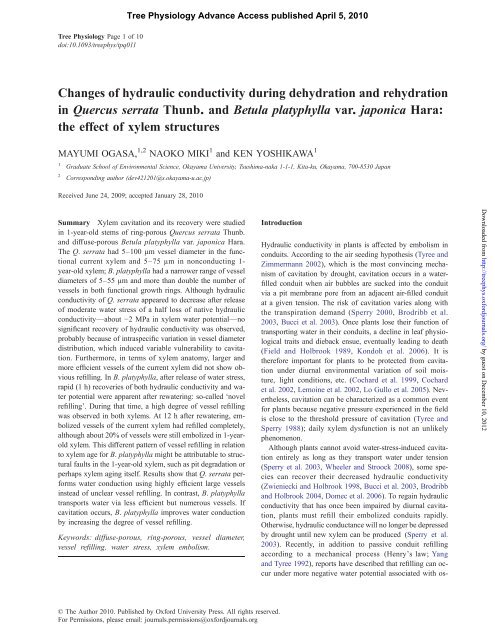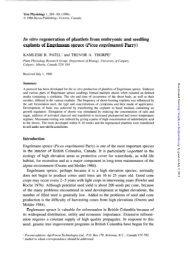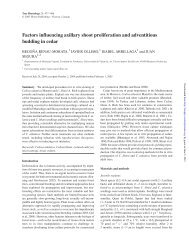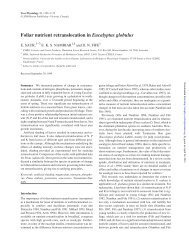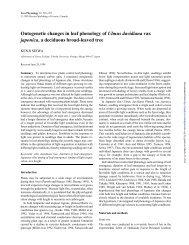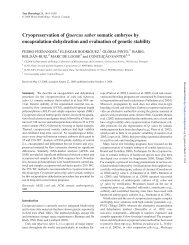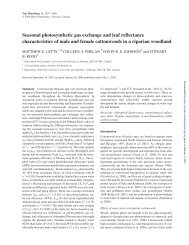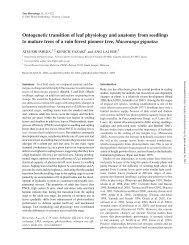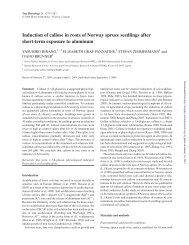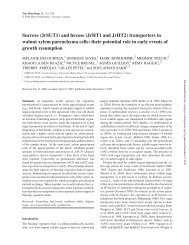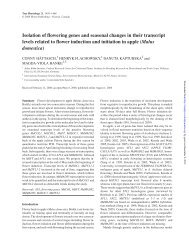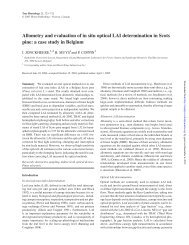Hara: the effect of xylem structures - Tree Physiology
Hara: the effect of xylem structures - Tree Physiology
Hara: the effect of xylem structures - Tree Physiology
You also want an ePaper? Increase the reach of your titles
YUMPU automatically turns print PDFs into web optimized ePapers that Google loves.
<strong>Tree</strong> <strong>Physiology</strong> Page 1 <strong>of</strong> 10<br />
doi:10.1093/treephys/tpq011<br />
<strong>Tree</strong> <strong>Physiology</strong> Advance Access published April 5, 2010<br />
Changes <strong>of</strong> hydraulic conductivity during dehydration and rehydration<br />
in Quercus serrata Thunb. and Betula platyphylla var. japonica <strong>Hara</strong>:<br />
<strong>the</strong> <strong>effect</strong> <strong>of</strong> <strong>xylem</strong> <strong>structures</strong><br />
MAYUMI OGASA, 1,2 NAOKO MIKI 1 and KEN YOSHIKAWA 1<br />
1 Graduate School <strong>of</strong> Environmental Science, Okayama University, Tsushima-naka 1-1-1, Kita-ku, Okayama, 700-8530 Japan<br />
2 Corresponding author (dev421201@s.okayama-u.ac.jp)<br />
Received June 24, 2009; accepted January 28, 2010<br />
Summary Xylem cavitation and its recovery were studied<br />
in 1-year-old stems <strong>of</strong> ring-porous Quercus serrata Thunb.<br />
and diffuse-porous Betula platyphylla var. japonica <strong>Hara</strong>.<br />
The Q. serrata had 5–100 µm vessel diameter in <strong>the</strong> functional<br />
current <strong>xylem</strong> and 5–75 µm in nonconducting 1year-old<br />
<strong>xylem</strong>; B. platyphylla had a narrower range <strong>of</strong> vessel<br />
diameters <strong>of</strong> 5–55 µm and more than double <strong>the</strong> number <strong>of</strong><br />
vessels in both functional growth rings. Although hydraulic<br />
conductivity <strong>of</strong> Q. serrata appeared to decrease after release<br />
<strong>of</strong> moderate water stress <strong>of</strong> a half loss <strong>of</strong> native hydraulic<br />
conductivity—about −2 MPa in <strong>xylem</strong> water potential—no<br />
significant recovery <strong>of</strong> hydraulic conductivity was observed,<br />
probably because <strong>of</strong> intraspecific variation in vessel diameter<br />
distribution, which induced variable vulnerability to cavitation.<br />
Fur<strong>the</strong>rmore, in terms <strong>of</strong> <strong>xylem</strong> anatomy, larger and<br />
more efficient vessels <strong>of</strong> <strong>the</strong> current <strong>xylem</strong> did not show obvious<br />
refilling. In B. platyphylla, after release <strong>of</strong> water stress,<br />
rapid (1 h) recoveries <strong>of</strong> both hydraulic conductivity and water<br />
potential were apparent after rewatering: so-called ‘novel<br />
refilling’. During that time, a high degree <strong>of</strong> vessel refilling<br />
was observed in both <strong>xylem</strong>s. At 12 h after rewatering, embolized<br />
vessels <strong>of</strong> <strong>the</strong> current <strong>xylem</strong> had refilled completely,<br />
although about 20% <strong>of</strong> vessels were still embolized in 1-yearold<br />
<strong>xylem</strong>. This different pattern <strong>of</strong> vessel refilling in relation<br />
to <strong>xylem</strong> age for B. platyphylla might be attributable to structural<br />
faults in <strong>the</strong> 1-year-old <strong>xylem</strong>, such as pit degradation or<br />
perhaps <strong>xylem</strong> aging itself. Results show that Q. serrata performs<br />
water conduction using highly efficient large vessels<br />
instead <strong>of</strong> unclear vessel refilling. In contrast, B. platyphylla<br />
transports water via less efficient but numerous vessels. If<br />
cavitation occurs, B. platyphylla improves water conduction<br />
by increasing <strong>the</strong> degree <strong>of</strong> vessel refilling.<br />
Keywords: diffuse-porous, ring-porous, vessel diameter,<br />
vessel refilling, water stress, <strong>xylem</strong> embolism.<br />
© The Author 2010. Published by Oxford University Press. All rights reserved.<br />
For Permissions, please email: journals.permissions@oxfordjournals.org<br />
Introduction<br />
Hydraulic conductivity in plants is affected by embolism in<br />
conduits. According to <strong>the</strong> air seeding hypo<strong>the</strong>sis (Tyree and<br />
Zimmermann 2002), which is <strong>the</strong> most convincing mechanism<br />
<strong>of</strong> cavitation by drought, cavitation occurs in a waterfilled<br />
conduit when air bubbles are sucked into <strong>the</strong> conduit<br />
via a pit membrane pore from an adjacent air-filled conduit<br />
at a given tension. The risk <strong>of</strong> cavitation varies along with<br />
<strong>the</strong> transpiration demand (Sperry 2000, Brodribb et al.<br />
2003, Bucci et al. 2003). Once plants lose <strong>the</strong>ir function <strong>of</strong><br />
transporting water in <strong>the</strong>ir conduits, a decline in leaf physiological<br />
traits and dieback ensue, eventually leading to death<br />
(Field and Holbrook 1989, Kondoh et al. 2006). It is<br />
<strong>the</strong>refore important for plants to be protected from cavitation<br />
under diurnal environmental variation <strong>of</strong> soil moisture,<br />
light conditions, etc. (Cochard et al. 1999, Cochard<br />
et al. 2002, Lemoine et al. 2002, Lo Gullo et al. 2005). Never<strong>the</strong>less,<br />
cavitation can be characterized as a common event<br />
for plants because negative pressure experienced in <strong>the</strong> field<br />
is close to <strong>the</strong> threshold pressure <strong>of</strong> cavitation (Tyree and<br />
Sperry 1988); daily <strong>xylem</strong> dysfunction is not an unlikely<br />
phenomenon.<br />
Although plants cannot avoid water-stress-induced cavitation<br />
entirely as long as <strong>the</strong>y transport water under tension<br />
(Sperry et al. 2003, Wheeler and Stroock 2008), some species<br />
can recover <strong>the</strong>ir decreased hydraulic conductivity<br />
(Zwieniecki and Holbrook 1998, Bucci et al. 2003, Brodribb<br />
and Holbrook 2004, Domec et al. 2006). To regain hydraulic<br />
conductivity that has once been impaired by diurnal cavitation,<br />
plants must refill <strong>the</strong>ir embolized conduits rapidly.<br />
O<strong>the</strong>rwise, hydraulic conductance will no longer be depressed<br />
by drought until new <strong>xylem</strong> can be produced (Sperry et al.<br />
2003). Recently, in addition to passive conduit refilling<br />
according to a mechanical process (Henry’s law;Yang<br />
and Tyree 1992), reports have described that refilling can occur<br />
under more negative water potential associated with os-<br />
Downloaded from<br />
http://treephys.oxfordjournals.org/<br />
by guest on December 10, 2012
2<br />
mosis than <strong>the</strong> mechanically expected potential in intact<br />
woody plants (Tyree et al. 1999, Salleo et al. 2004, 2006).<br />
The conduit diameter can strongly affect <strong>the</strong> conductive efficiency<br />
<strong>of</strong> <strong>the</strong> <strong>xylem</strong>. According to Poiseuille’s law for ideal<br />
capillaries, <strong>the</strong> flow rate is proportional to <strong>the</strong> fourth power <strong>of</strong><br />
<strong>the</strong> radius <strong>of</strong> <strong>the</strong> capillary (Tyree and Zimmermann 2002),<br />
which demonstrates that a slight increase in conduit diameter<br />
brings about a considerable increase in water flow. Hydraulic<br />
conductivity is determined by <strong>the</strong> extent <strong>of</strong> functional conduits—by<br />
<strong>the</strong>ir number and width—so that <strong>xylem</strong> recovery<br />
depends on <strong>the</strong> extent <strong>of</strong> conduit refilling. For example, even<br />
if <strong>the</strong> numbers <strong>of</strong> refilled conduits were equal, conduits with<br />
larger diameter would provide sharp recovery <strong>of</strong> hydraulic<br />
conductivity. Reportedly, <strong>the</strong> extent <strong>of</strong> conducting conduits<br />
<strong>of</strong> wood would determine its hydraulic conductivity so that<br />
ring-porous species bearing large vessels would yield efficient<br />
<strong>xylem</strong> conductivity, whereas diffuse-porous species<br />
have many small but less efficient vessels (Tyree and<br />
Zimmermann 2002, Hacke et al. 2006). Until now, many<br />
studies have described <strong>the</strong> water-conducting properties <strong>of</strong><br />
woody plants merely in terms <strong>of</strong> water-stressed conditions<br />
(e.g., Hargrave et al. 1994, Hacke et al. 2006). Along with<br />
<strong>the</strong> results <strong>of</strong> those studies, incorporating <strong>the</strong> conditions after<br />
water-stress release will advance <strong>the</strong> evaluation <strong>of</strong> <strong>the</strong> conducting<br />
strategy because <strong>the</strong> recovery <strong>of</strong> hydraulic conductivity has<br />
actually been performed (Zwieniecki and Holbrook 1998,<br />
Bucci et al. 2003). Then, ring-porous trees might have less<br />
ability to refill vessels cavitated by drought because <strong>the</strong> remaining<br />
functional large vessels are still efficient. In contrast,<br />
diffuse-porous trees might require high ability <strong>of</strong> vessel refilling<br />
to regain lost cavitated vessels because <strong>the</strong> remaining functional<br />
vessels are too narrow and not sufficiently efficient to<br />
conduct water after water-stress release.<br />
In our study, we specifically investigated <strong>the</strong> <strong>effect</strong> <strong>of</strong> <strong>xylem</strong><br />
<strong>structures</strong> on water-conducting properties during daily<br />
water stress and its subsequent release. We attempted to evaluate<br />
<strong>the</strong> extent <strong>of</strong> cavitation and <strong>xylem</strong> recovery in saplings<br />
<strong>of</strong> ring-porous Quercus serrata Thunb. and diffuse-porous<br />
Betula platyphylla var. japonica <strong>Hara</strong>. We discuss hydraulic<br />
properties not only under water stress but also after its release<br />
in <strong>the</strong>se porous-wood trees. We determined <strong>the</strong> extent <strong>of</strong> hydraulic<br />
conductivity and functional or embolized vessels during<br />
dehydration and rehydration phases.<br />
Materials and methods<br />
Plant materials<br />
Experiments were conducted on potted 2- to 3-year-old<br />
plants <strong>of</strong> Q. serrata, ring-porous wood, and B. platyphylla<br />
var. japonica,diffuse-porous wood, during summer: August–<br />
October 2008. All <strong>the</strong>se plants were grown in an experimental<br />
field at Okayama University (34°41′ N, 133°53′ E) and were<br />
well watered regularly until <strong>the</strong> experiments were conducted.<br />
OGASA ET AL.<br />
TREE PHYSIOLOGY<br />
The plants, which were <strong>of</strong> almost uniform size, were 1.45 ±<br />
0.09 m tall for Q. serrata and 1.68 ± 0.23 m tall for B. platyphylla.<br />
Stems holding two annual rings, located in <strong>the</strong> middle<br />
part <strong>of</strong> <strong>the</strong> main stem, were used for experiments. We confirmed<br />
that <strong>the</strong> stem segments that were studied had current<br />
and 1-year-old <strong>xylem</strong> by using a stereoscopic microscope<br />
(SZX-ILLB100; Olympus Optical Co., Ltd, Japan) to count<br />
annual rings in a cross section cut from <strong>the</strong> segments after<br />
<strong>the</strong> experiments. Only data obtained from <strong>the</strong> segments holding<br />
two annual rings were used for analyses.<br />
Dehydration experiments and hydraulic conductivity<br />
measurements<br />
Potted plants were dried by stopping irrigation for several<br />
days to a week and <strong>the</strong>n transporting <strong>the</strong>m to <strong>the</strong> laboratory<br />
for experimentation. To ensure that <strong>the</strong> target water potential<br />
was obtained, plants were dehydrated more slowly after<br />
transport to <strong>the</strong> laboratory. Plants’ water status was monitored<br />
by measuring <strong>the</strong> leaf water potential regularly using a pressure<br />
chamber (model 600; PMS Instrument Co., USA). When<br />
<strong>the</strong> leaf water potential was close to a target value, three randomly<br />
chosen leaves were enclosed for at least 24 h in a<br />
black plastic bag to remove <strong>the</strong> water potential gradient between<br />
<strong>the</strong> <strong>xylem</strong> and leaf. The whole plant was also enclosed<br />
for at least 2 h in a black plastic bag to stop transpiration and<br />
to stabilize <strong>the</strong> <strong>xylem</strong> tension. Subsequently, <strong>the</strong> <strong>xylem</strong> water<br />
potential, Ψ<strong>xylem</strong>, was obtained by measuring <strong>the</strong> water potential<br />
on three previously enclosed leaves using a pressure<br />
chamber (bagged shoot method, e.g., Turner 1981); <strong>the</strong> mean<br />
was applied as plant Ψ <strong>xylem</strong>.<br />
At various values <strong>of</strong> stem Ψ <strong>xylem</strong>, a stem segment holding<br />
two annual rings was cut underwater from <strong>the</strong> middle<br />
height <strong>of</strong> <strong>the</strong> main stem <strong>of</strong> <strong>the</strong> plant. The segments were 0.4–<br />
0.8 cm in diameter and around 5 cm long. We considered that<br />
open vessels in <strong>the</strong> segment <strong>of</strong> ring-porous Q. serrata had less<br />
<strong>effect</strong> on <strong>the</strong> initial hydraulic conductivity (K init) because K init<br />
had not changed depending on <strong>the</strong> segment length in preliminary<br />
experiments. After cutting <strong>the</strong> segments, K init was<br />
measured immediately for perfusion with a 0.1-µm-filtered<br />
20 mM KCl solution. Measurements were performed using<br />
a conductivity apparatus (Sperry et al. 1988) under hydrostatic<br />
pressure <strong>of</strong> 30 cm hydraulic head for Q. serrata and<br />
60 cm for B. platyphylla. Axial flow, F, was recorded after<br />
it became stable. The values <strong>of</strong> K init were calculated as<br />
shown below.<br />
Kinit = F= ðΔP=LÞ ð1Þ<br />
Therein, ΔP signifies <strong>the</strong> pressure difference across <strong>the</strong><br />
segment length L. After K init was determined, segments<br />
were flushed with <strong>the</strong> filtered KCl solution at 100 kPa<br />
for 20 min and remeasured for <strong>the</strong>ir maximum hydraulic<br />
conductivity, K max, from Eq. (1) at hydrostatic pressure.<br />
We had confirmed previously that segments reached K max<br />
Downloaded from<br />
http://treephys.oxfordjournals.org/ by guest on December 10, 2012
Figure 1. Relationship between loss <strong>of</strong> hydraulic conductivity and Ψ<strong>xylem</strong> in A, Q. serrata and B, B. platyphylla. Each point represents one<br />
stem. The solid line shows <strong>the</strong> regression curve.<br />
after 20 min flushing at 100 kPa. The percentage loss <strong>of</strong><br />
hydraulic conductivity (PLC) was <strong>the</strong>n calculated as <strong>the</strong><br />
following.<br />
PLC = ð1−Kinit=KmaxÞ × 100 ð2Þ<br />
Data were presented as relationships <strong>of</strong> PLC to Ψ <strong>xylem</strong> that<br />
induced <strong>the</strong> embolism, indicating vulnerability curves as in<br />
Figure 1 in which each plot referred to one value <strong>of</strong> one<br />
segment cut from a plant. The following sigmoid function<br />
was fitted to <strong>the</strong> experimental vulnerability curves (Pammenter<br />
and van der Willigen 1998).<br />
PLC = 100= 1 + exp a Ψ<strong>xylem</strong>−Ψ50<br />
ð3Þ<br />
In that equation, a signifies <strong>the</strong> slope <strong>of</strong> <strong>the</strong> curve, and Ψ 50<br />
denotes <strong>the</strong> Ψ <strong>xylem</strong> value that yields 50 PLC. The specific<br />
hydraulic conductivity, K s, was obtained by dividing K init<br />
by <strong>the</strong> functional <strong>xylem</strong> cross-sectional area <strong>of</strong> <strong>the</strong> segment.<br />
For each species, 17 plants were used for dehydration<br />
experiments.<br />
LOSS OF XYLEM CONDUCTIVITY AND ITS RECOVERY 3<br />
Rehydration experiments<br />
After stopping irrigation, potted plants were dehydrated to<br />
−1.5 to −2.0 MPa for Q. serrata and −1.7 to −2.0 MPa for<br />
B. platyphylla in leaf water potential, which was sufficiently<br />
low to cause <strong>the</strong> predicted half loss <strong>of</strong> hydraulic conductivity<br />
against well-watered status by <strong>the</strong> vulnerability curve; leaves<br />
were not wilted completely for ei<strong>the</strong>r species (Ranney et al.<br />
1991, Saito and Terashima 2004). These water-stressed potted<br />
plants were rewatered well to field capacity. They were<br />
kept in <strong>the</strong> laboratory for 1 and 12 h after rewatering to simulate<br />
overnight rehydration periods (Nardini et al. 2008). The<br />
photosyn<strong>the</strong>tic photon flux density (PPFD) and air temperature<br />
were, respectively, 0–13 µmol m −2 s −1 and 26°C in <strong>the</strong><br />
laboratory. Unlike <strong>the</strong> dehydration experiment, whole plants<br />
were not enclosed during rehydration. At <strong>the</strong> end <strong>of</strong> each rehydration<br />
period, Ψ <strong>xylem</strong> was obtained from three leaves that<br />
had been previously enclosed for 24 h; Kinit <strong>of</strong> a 5-cm-long<br />
stem segment cut from a plant was measured under <strong>the</strong> same<br />
hydrostatic pressure using <strong>the</strong> same apparatus described in<br />
<strong>the</strong> previous section. Specific hydraulic conductivity (K s),<br />
Figure 2. Specific hydraulic conductivity as measured in nondehydrated, dehydrated and rehydrated stem segments cut from Q. serrata (A) and<br />
B. platyphylla (B) 1 and 12 h after rewatering. Mean ± SD (n = 3). **P < 0.01 denotes a significant difference against nondehydrated segments<br />
for Dunnett’s test.<br />
TREE PHYSIOLOGY ONLINE at http://www.treephys.oxfordjournals.org<br />
Downloaded from<br />
http://treephys.oxfordjournals.org/ by guest on December 10, 2012
4<br />
Figure 3. Xylem water potential as measured in nondehydrated, dehydrated and rehydrated stem segments cut from <strong>the</strong> plants 1 and 12 h after<br />
rewatering in Q. serrata (A) and B. platyphylla (B). Mean ± SD (n = 3). **P < 0.01 and ***P < 0.001 denote significant differences from<br />
nondehydrated segments for Dunnett’s test.<br />
obtained by dividing Kinit by <strong>the</strong> functional <strong>xylem</strong> crosssectional<br />
area, was used as an indicator <strong>of</strong> <strong>the</strong> recovery <strong>of</strong><br />
hydraulic conductivity to rule out embolism in situ. Rehydration<br />
experiments were conducted on three plants in<br />
each 1- and 12-h rehydration period for both species. In<br />
addition, out <strong>of</strong> 17 plants used for dehydration experiments,<br />
three plants before dehydration and three plants after<br />
moderate dehydration, which were <strong>of</strong> <strong>the</strong> same<br />
dehydrated condition immediately before rewatering, were<br />
selected and used for a comparison <strong>of</strong> Ks or <strong>xylem</strong> water<br />
potential at different water statuses (see Figures 2 and 3).<br />
Xylem anatomy<br />
We analyzed <strong>the</strong> <strong>xylem</strong> anatomy on various plant water<br />
statuses—before and after dehydration (about 0 and −2<br />
MPa in Ψ <strong>xylem</strong>, respectively) and 1 and 12 h after rewatering—to<br />
compare <strong>the</strong> changes in functional and embolized<br />
vessel size distribution with water status. Segments for anatomical<br />
measurements were excised underwater from <strong>the</strong><br />
same stems and a significantly closer position where hydraulic<br />
measurements were conducted. They were perfused<br />
with 0.1% wt/vol. <strong>of</strong> 0.1-µm-filtered safranin dye to distinguish<br />
functional vessels from embolized ones (Sperry et al.<br />
1994, Kondoh et al. 2006). Dye perfusion was performed<br />
in <strong>the</strong> same setting as that <strong>of</strong> hydraulic measurements under<br />
hydrostatic pressure <strong>of</strong> 30 cm hydraulic head for Q.<br />
OGASA ET AL.<br />
serrata and 60 cm for B. platyphylla. After dye perfusion,<br />
30-µm-thick cross sections were obtained from <strong>the</strong> middle<br />
part <strong>of</strong> dye-perfused segments using a sliding microtome<br />
and observed using a stereoscopic microscope. For each<br />
cross section, we randomly chose a 30° (inner-angle) sector<br />
<strong>of</strong> <strong>xylem</strong> that was delimited continuously by two radial<br />
rays from <strong>the</strong> pith to cambium and measured all<br />
functional and embolized vessel numbers and lumen areas<br />
within this sector for each growth ring. The stained functional<br />
vessel and unstained embolized vessel diameters<br />
were calculated as <strong>the</strong> diameter <strong>of</strong> a circle with an area<br />
equal to <strong>the</strong> measured lumen area. In addition to <strong>the</strong><br />
vessel diameter distribution in <strong>the</strong> 5-µm size class for current<br />
and 1-year-old <strong>xylem</strong>, we calculated <strong>the</strong> percentage<br />
number <strong>of</strong> functional or embolized vessels to that <strong>of</strong> all<br />
vessels belonging to each size class to assess <strong>the</strong> dependence<br />
<strong>of</strong> vessel size on sensitivity to dehydration and rehydration.<br />
We measured <strong>the</strong> vessel diameter using three<br />
cross sections cut from each three plant-stem segment<br />
for each water status and from three additional segments,<br />
and analyzed <strong>the</strong> current and 1-year-old <strong>xylem</strong> separately.<br />
Theoretical specific hydraulic conductivity<br />
Based on Poiseuille’s law for ideal capillaries, <strong>the</strong>oretical Ks<br />
(kg m −1 MPa −1 s −1 ) was calculated for <strong>the</strong> only stained func-<br />
Table 1. Percentage <strong>of</strong> <strong>the</strong> functional vessel number on each <strong>xylem</strong> and <strong>the</strong> current <strong>xylem</strong> contribution to whole-<strong>xylem</strong> specific conductivity<br />
(K s), as calculated from <strong>the</strong> functional vessel diameter for well-watered plants <strong>of</strong> Q. serrata and B. platyphylla. Mean ± SD (n = 3 per species).<br />
Percentage <strong>of</strong> functional vessels Current <strong>xylem</strong> contribution in K s (%)<br />
Current <strong>xylem</strong> 1-year-old <strong>xylem</strong><br />
Q. serrata 60.6 ± 8.7 21.5 ± 18.6 99.5 ± 0.5<br />
B. platyphylla 100.0 ± 0.0 100.0 ± 0.0 48.6 ± 0.0<br />
TREE PHYSIOLOGY<br />
Downloaded from<br />
http://treephys.oxfordjournals.org/ by guest on December 10, 2012
tional vessels in each <strong>xylem</strong> <strong>of</strong> <strong>the</strong> cross section, as shown<br />
below (Tyree and Ewers 1991).<br />
<strong>the</strong>oretical Ks ¼ ðπρ=128ηAwÞ∑ n<br />
i−1<br />
d 4 i<br />
ð4Þ<br />
In that equation, ρ represents <strong>the</strong> density <strong>of</strong> <strong>the</strong> solution<br />
(kg m −3 ), η is <strong>the</strong> dynamic viscosity <strong>of</strong> <strong>the</strong> solution<br />
(MPa s), A w signifies <strong>the</strong> <strong>xylem</strong> cross-sectional area (m 2 ),<br />
d denotes <strong>the</strong> diameter (m) <strong>of</strong> <strong>the</strong> ith vessel and n stands<br />
for <strong>the</strong> number <strong>of</strong> vessels in <strong>the</strong> section observed for <strong>xylem</strong><br />
anatomy. Calculation <strong>of</strong> <strong>the</strong>oretical K s before dehydration<br />
was conducted on three cross sections analyzed for <strong>xylem</strong><br />
anatomy to evaluate <strong>the</strong> contribution <strong>of</strong> current <strong>xylem</strong> hydraulic<br />
conductivity to <strong>the</strong> hydraulic conductivity <strong>of</strong> <strong>the</strong><br />
whole <strong>xylem</strong> (see Table 1). Fur<strong>the</strong>rmore, <strong>the</strong>oretical K s obtained<br />
from three cross sections for each water status—<br />
after dehydration and two rehydration periods in addition<br />
to ‘before dehydration’—are shown for diffuse-porous B.<br />
platyphylla to examine <strong>the</strong> <strong>effect</strong>s <strong>of</strong> <strong>xylem</strong> age on <strong>the</strong><br />
extent <strong>of</strong> vessel refilling and consequently on <strong>the</strong> recovery<br />
<strong>of</strong> measured K s (see Figure 7).<br />
Statistical analyses<br />
One-way ANOVA was used to test <strong>the</strong> <strong>effect</strong> <strong>of</strong> different water<br />
status on hydraulic conductivity or <strong>xylem</strong> water potential.<br />
Dunnett’s test was applied for multiple comparisons among<br />
water status. S<strong>of</strong>tware (Statistica; StatS<strong>of</strong>t Inc. USA) was<br />
used for statistical analyses.<br />
LOSS OF XYLEM CONDUCTIVITY AND ITS RECOVERY 5<br />
Figure 4. Vessel diameter distribution in 5 μm classes in Q. serrata (A, B) and B. platyphylla (C, D). A and C show data for <strong>the</strong> current <strong>xylem</strong>,<br />
B and D show 1-year-old <strong>xylem</strong>. Class means ± SD (n = 15). Data in each graph represent mean ± SD <strong>of</strong> <strong>the</strong> vessel number (vessel mm −2 ) and<br />
diameter (µm).<br />
Results<br />
Dehydration vulnerability curves<br />
Although <strong>the</strong> data presented herein varied widely throughout<br />
<strong>xylem</strong> water potential, about 40% loss <strong>of</strong> hydraulic conductivity<br />
was recorded in <strong>the</strong> high <strong>xylem</strong> water potential in Q.<br />
serrata (Figure 1A). The percentage loss <strong>of</strong> hydraulic conductivity<br />
increased slightly with decreasing Ψ<strong>xylem</strong> values.<br />
By contrast, B. platyphylla showed no loss <strong>of</strong> hydraulic<br />
conductivity <strong>of</strong> Ψ <strong>xylem</strong> values between 0 and −1.5 MPa<br />
(Figure 1B). At lower Ψ <strong>xylem</strong> values, <strong>the</strong> percentage loss <strong>of</strong><br />
hydraulic conductivity <strong>the</strong>n increased sharply. At Ψ<strong>xylem</strong> <strong>of</strong><br />
less than −2.0 MPa, <strong>the</strong> loss <strong>of</strong> hydraulic conductivity was<br />
raised more than 80%.<br />
Recovery <strong>of</strong> hydraulic conductivity and Ψ <strong>xylem</strong><br />
Specific conductivity (K s)inQ. serrata was decreased by dehydration<br />
from 12.0 kg m −1 MPa −1 s −1 under well-watered<br />
conditions to 7.0 kg m −1 MPa −1 s −1 (Figure 2A) after rewatering,<br />
but no significant difference was found between <strong>the</strong>m.<br />
In addition, <strong>the</strong> mean values <strong>of</strong> K s did not recover significantly<br />
in ei<strong>the</strong>r 1- or 12-h rehydration periods. In contrast, B. platyphylla<br />
exhibited a significant loss <strong>of</strong> K s from 2.9 to 1.4 kg<br />
m −1 MPa −1 s −1 by dehydration but recovered rapidly to <strong>the</strong><br />
value equal to that under well-watered conditions (1 h)<br />
(Figure 2B). Comparison <strong>of</strong> K s values among species shows<br />
that Q. serrata displayed higher hydraulic efficiency than B.<br />
platyphylla through water status.<br />
TREE PHYSIOLOGY ONLINE at http://www.treephys.oxfordjournals.org<br />
Downloaded from<br />
http://treephys.oxfordjournals.org/ by guest on December 10, 2012
6<br />
Figure 5. Percentage <strong>of</strong> functional and embolized vessels in each <strong>of</strong> <strong>the</strong> 5-µm classes in Q. serrata. Gray and open bars, respectively, represent<br />
functional and embolized vessels: A–D are for <strong>the</strong> current <strong>xylem</strong>; E–H are for <strong>the</strong> 1-year-old <strong>xylem</strong>; A and E, before dehydration; B and F, after<br />
dehydration; C and G, 1 h after rewatering; D and H, 12 h after rewatering. Class mean ± 95% <strong>of</strong> <strong>the</strong> confidence interval (n = 3).<br />
Although no significant change <strong>of</strong> loss <strong>of</strong> hydraulic conductivity<br />
was observed by rewatering in Q. serrata, Ψ <strong>xylem</strong><br />
was significantly improved 1 h after rewatering (Figure 3A).<br />
During <strong>the</strong> 12-h rehydration period, Ψ <strong>xylem</strong> was recovered<br />
completely to be equivalent to <strong>the</strong> nondehydrated value.<br />
Similarly, B. platyphylla showed considerable recovery <strong>of</strong><br />
Ψ<strong>xylem</strong> in 1 h <strong>of</strong> rehydration period and <strong>the</strong>n recovered fully<br />
in 12 h.<br />
Xylem anatomy<br />
Results show that Q. serrata had widely differing vessel diameters<br />
<strong>of</strong> 5–100 and 5–75 µm in <strong>the</strong> current and 1-year-old<br />
<strong>xylem</strong>, respectively (Figures 4A and B). The percentage<br />
OGASA ET AL.<br />
TREE PHYSIOLOGY<br />
number <strong>of</strong> functional vessels was 60.6 ± 8.7% in current <strong>xylem</strong><br />
and 21.5 ± 18.6% in 1-year-old <strong>xylem</strong>, and <strong>the</strong> contribution<br />
<strong>of</strong> current <strong>xylem</strong> to whole-<strong>xylem</strong> specific hydraulic<br />
conductivity was 99.5 ± 0.5% (Table 1). In B. platyphylla,<br />
by contrast, <strong>the</strong> vessels showed a narrower range <strong>of</strong> diameters<br />
<strong>of</strong> 5–55 µm, and many more vessels were present in both<br />
aged <strong>xylem</strong> than Q. serrata had (Figures 4C and D). Fur<strong>the</strong>rmore,<br />
all vessels were functional in <strong>the</strong> whole <strong>xylem</strong> under a<br />
well-watered condition. The current and 1-year-old <strong>xylem</strong><br />
showed similar water conduction (Table 1).<br />
During dehydration for Q. serrata, <strong>the</strong> percentage numbers<br />
<strong>of</strong> functional vessels in <strong>the</strong> respective size classes did not differ<br />
markedly for vessel diameters <strong>of</strong> 5–50 µm in <strong>the</strong> current<br />
<strong>xylem</strong>, but for vessel diameters larger than 50 µm, more ves-<br />
Downloaded from<br />
http://treephys.oxfordjournals.org/ by guest on December 10, 2012
sels seemed to be embolized by dehydration (Figures 5B vs.<br />
A). After rewatering, embolized vessels in some size classes <strong>of</strong><br />
current <strong>xylem</strong> were refilled 1 h after rewatering (Figure 5C).<br />
The refilling was clearer in smaller vessels for 12-h rehydration<br />
(Figure 5D). In 1-year-old <strong>xylem</strong>, most vessels had already<br />
embolized in <strong>the</strong> absence <strong>of</strong> water stress (Figure 5E), as reported<br />
previously (Sperry and Sullivan 1992, Cochard<br />
2006), and remained embolized, irrespective <strong>of</strong> rewatering<br />
(Figures 5F–H).<br />
In B. platyphylla, although all sizes <strong>of</strong> vessel were functional<br />
before dehydration in current and 1-year-old <strong>xylem</strong><br />
(Figures 6A and E), 50% or more <strong>of</strong> vessels in each size class<br />
were embolized when water stress was induced (Figures 6B<br />
and F). Larger vessels were embolized by dehydration, espe-<br />
LOSS OF XYLEM CONDUCTIVITY AND ITS RECOVERY 7<br />
Figure 6. Percentage <strong>of</strong> functional and embolized vessels in each 5-µm class in B. platyphylla. Gray and open bars, respectively, represent<br />
functional and embolized vessels: A–D show data for current <strong>xylem</strong>; E–H are for 1-year-old <strong>xylem</strong>; A and E, before dehydration; B and F, after<br />
dehydration; C and G, 1 h after rewatering; D and H, 12 h after rewatering. Class mean ± 95% <strong>of</strong> <strong>the</strong> confidence interval (n = 3).<br />
cially in 1-year-old <strong>xylem</strong>. The rapid refilling <strong>of</strong> <strong>xylem</strong> vessels<br />
was observed during 1-h rehydration (Figures 6C and G).<br />
At 12 h after rewatering, most vessels in all classes had fully<br />
refilled in <strong>the</strong> current <strong>xylem</strong> (Figure 6D), although about 20%<br />
<strong>of</strong> vessels were still embolized in 1-year-old <strong>xylem</strong><br />
(Figure 6H). At 1 h after rewatering, larger vessels <strong>of</strong> current<br />
<strong>xylem</strong> appeared to be embolized still; <strong>the</strong>y were cases in<br />
which vessels <strong>of</strong> more than 50 µm diameter belonged to only<br />
one plant.<br />
Composition <strong>of</strong> Ks in B. platyphylla<br />
Theoretical specific hydraulic conductivity (K s) in current<br />
and 1-year-old <strong>xylem</strong> <strong>of</strong> B. platyphylla is portrayed in Fig-<br />
TREE PHYSIOLOGY ONLINE at http://www.treephys.oxfordjournals.org<br />
Downloaded from<br />
http://treephys.oxfordjournals.org/<br />
by guest on December 10, 2012
8<br />
Figure 7. Theoretical specific hydraulic conductivity in current (A) and 1-year-old (B) <strong>xylem</strong> for B. platyphylla as measured in nondehydrated,<br />
dehydrated and rehydrated stem segments 1 and 12 h after rewatering. Mean ± SD (n = 3). NS denotes a nonsignificant difference compared<br />
with nondehydrated segments (P < 0.05) for Dunnett’s test.<br />
ure 7. In current <strong>xylem</strong>, no significant loss <strong>of</strong> <strong>the</strong>oretical K s<br />
was observed; it was <strong>the</strong> same as that at 1 or 12 h after rewatering<br />
(Figure 7A). In 1-year-old <strong>xylem</strong>, loss <strong>of</strong> more than<br />
half <strong>of</strong> <strong>the</strong> mean <strong>the</strong>oretical K s was observed by dehydration<br />
and was apparently recovered by rewatering, but no change<br />
was found to be statistically significant (Figure 7B), probably<br />
because <strong>of</strong> large variation in <strong>the</strong> data.<br />
Discussion<br />
During plant dehydration, <strong>the</strong> percentage loss <strong>of</strong> hydraulic<br />
conductivity <strong>of</strong> ring-porous Q. serrata was scattered throughout<br />
a range <strong>of</strong> <strong>xylem</strong> water potential (Figure 1). These widely<br />
varied values among individuals <strong>of</strong> Q. serrata might result<br />
from intraspecific variation in <strong>xylem</strong> cavitation. Some reports<br />
have described that intraspecific variation exists in <strong>xylem</strong><br />
cavitation and hydraulic mean vessel diameter (Sperry and<br />
Saliendra 1994, Matzner et al. 2001). Therefore, slight differences<br />
<strong>of</strong> <strong>the</strong> maximum functional vessel diameter might invite<br />
a great <strong>effect</strong> on <strong>the</strong> extent loss <strong>of</strong> hydraulic conductivity<br />
<strong>of</strong> plants, especially in big-vessel-bearing species. For Q. serrata,<br />
which shows variation in distribution <strong>of</strong> vessel diameter<br />
(Figures 4 and 5), it would be <strong>the</strong> case in which vulnerability<br />
curves might appear as various shapes among individuals, although<br />
intraspecific variation in structural pit properties remains<br />
unclear. O<strong>the</strong>r studies have also shown vulnerability<br />
curves <strong>of</strong> ring-porous species with larger deviations than that<br />
<strong>of</strong> diffuse-porous species (e.g., Sperry and Sullivan 1992).<br />
Considering <strong>the</strong>se facts, however, it can be inferred that 1year-old<br />
<strong>xylem</strong> almost loses its water transport function, even<br />
under high <strong>xylem</strong> water potential, <strong>the</strong>reby contributing to a<br />
high PLC and increasing PLC by small degrees with decreasing<br />
Ψ<strong>xylem</strong>. This lack <strong>of</strong> a clear pattern <strong>of</strong> <strong>xylem</strong> recovery was<br />
observed after rewatering in Q. serrata (Figure 2), although <strong>the</strong><br />
<strong>xylem</strong> water potential recovered completely with time (Figure<br />
3). By contrast, diffuse-porous B. platyphylla exhibited<br />
a critical <strong>xylem</strong> water potential at which a distinct loss <strong>of</strong><br />
OGASA ET AL.<br />
TREE PHYSIOLOGY<br />
hydraulic conductivity was shown (Figure 1). In addition,<br />
this study provided clear evidence that <strong>the</strong> loss <strong>of</strong> hydraulic<br />
conductivity by natural drought was recovered rapidly<br />
(1 h after rewatering), reverting to <strong>the</strong> values shown for <strong>the</strong><br />
well-watered status despite incomplete repair <strong>of</strong> <strong>the</strong> <strong>xylem</strong> water<br />
potential through ‘novel refilling’, as reported by Hacke<br />
and Sperry (2003). Recent studies also showed asynchrony<br />
between <strong>the</strong> recovery <strong>of</strong> specific conductivity and recovery<br />
<strong>of</strong> <strong>the</strong> <strong>xylem</strong> water potential (Hacke and Sperry 2003, Nardini<br />
et al. 2008) and/or hysteresis between dehydration and<br />
rehydration courses (Hacke et al. 2001, Stiller et al. 2005).<br />
Rapid <strong>xylem</strong> recovery in <strong>the</strong> absence <strong>of</strong> root pressure was<br />
performed even under tension by operations such as osmosis<br />
because <strong>of</strong> starch-to-sugar conversion in wood parenchyma<br />
cells or because <strong>of</strong> increased concentration <strong>of</strong> inorganic<br />
ions in <strong>xylem</strong> sap, as reported in <strong>the</strong> field by Buccietal.<br />
(2003) or as demonstrated experimentally by Tyree et al.<br />
(1999) and Salleo et al. (2004, 2006). Our results also support<br />
<strong>the</strong>ir suggestions with respect to <strong>the</strong> actual Ψ<strong>xylem</strong> during rehydration<br />
being sufficiently lower than Ψ <strong>xylem</strong> refilling<br />
(Ψ conduit refilling = −2T/r, where T is <strong>the</strong> surface tension <strong>of</strong><br />
water and r is <strong>the</strong> conduit radius (m); Yang and Tyree<br />
1992), as calculated from mean refilled vessel diameter<br />
(−0.4 vs. −0.015 MPa in Q. serrata and −0.2 vs. −0.016<br />
MPa in B. platyphylla, at 25°C). Results <strong>of</strong> <strong>the</strong> present<br />
study show—for evaluation <strong>of</strong> <strong>the</strong> extent <strong>of</strong> vessel refilling—that<br />
<strong>the</strong> intensity <strong>of</strong> water stress was set at a level<br />
where leaves were not wilted completely for Q. serrata<br />
(Saito and Terashima 2004) and B. platyphylla (Ranney et<br />
al. 1991) and plants were dried naturally at <strong>the</strong> whole plant<br />
level to evaluate daily possible refilling under natural conditions.<br />
Salleo et al. (1996) described that <strong>the</strong> degree <strong>of</strong> hydraulic<br />
conductivity recovery would change depending on<br />
<strong>the</strong> intensity <strong>of</strong> <strong>the</strong> water stress to which plants were subjected:<br />
a limiting point would exist at which <strong>the</strong> cavitated<br />
vessel refilled rapidly. Even though plants can eventually<br />
resprout after severe water stress (Viagrosa et al. 2003), if<br />
such stress greatly exceeds <strong>the</strong> wilting point <strong>of</strong> leaves, un-<br />
Downloaded from<br />
http://treephys.oxfordjournals.org/ by guest on December 10, 2012
like our case, <strong>the</strong>n embolized vessels might be refilled only<br />
slightly—not only quickly but even overnight.<br />
The high degree <strong>of</strong> 1-h rapid refilling <strong>of</strong> <strong>the</strong> embolized<br />
vessels in B. platyphylla, which is observed in all size<br />
classes <strong>of</strong> both current and 1-year-old <strong>xylem</strong>, provided rapid<br />
recovery <strong>of</strong> <strong>the</strong> hydraulic conductivity (Figure 6). Embolized<br />
vessels <strong>of</strong> <strong>the</strong> current <strong>xylem</strong> were almost refilled<br />
by taking sufficient times <strong>of</strong> 12 h. It is notable that about<br />
20% or more <strong>of</strong> vessels <strong>of</strong> any size class in 1-year-old <strong>xylem</strong><br />
had been embolized, which indicates that cavitation in<br />
1-year-old <strong>xylem</strong> vessels cannot be refilled during a single<br />
day (17.10 ± 13.67% (mean ± SD, n = 3) in PLC <strong>of</strong> B.<br />
platyphylla stems at 24 h after rewatering, data not shown).<br />
Therefore, although <strong>the</strong> extent <strong>of</strong> conducting vessels did<br />
not affect <strong>the</strong> <strong>xylem</strong> specific conductivity for different water<br />
status irrespective <strong>of</strong> <strong>xylem</strong> age (Figure 7), different refilling<br />
patterns between <strong>xylem</strong> ages might leave insufficient<br />
time for refilling, with some structural fault in 1-year-old<br />
<strong>xylem</strong>, such as pit degradation (Sperry et al. 1991) or perhaps<br />
aging itself, even though both aged vessels were fully<br />
conducted under well-watered conditions. In contrast, for Q.<br />
serrata, some vessel refilling in current <strong>xylem</strong> was apparent<br />
in each size class, especially more in small size classes than<br />
in larger size classes, while vessels <strong>of</strong> <strong>the</strong> 1-year-old <strong>xylem</strong><br />
remained embolized after rewatering (Figure 5). This might<br />
result from greater sensibility <strong>of</strong> smaller vessels for refilling<br />
mechanically or priority <strong>of</strong> small vessels phenologically<br />
than that <strong>of</strong> larger vessels in relation to preparation for next<br />
year’s growth.<br />
Pits are pathways not only <strong>of</strong> water but also <strong>of</strong> air during<br />
drought-induced cavitation (Sperry and Tyree 1988, Tyree<br />
and Zimmermann 2002). In relation to <strong>the</strong> <strong>xylem</strong> structure,<br />
our results, showing that dependence <strong>of</strong> cavitation on vessel<br />
size was seemingly observed in ei<strong>the</strong>r <strong>the</strong> studied species or<br />
o<strong>the</strong>r species (Hargrave et al. 1994), imply that <strong>the</strong> pit distribution<br />
depends on <strong>the</strong> vessel size. As reported by Wheeler et<br />
al. (2005) and Hacke et al. (2006), <strong>the</strong> total pit area per vessel<br />
determines <strong>the</strong> safety to cavitation interspecifically. Considering<br />
our cases <strong>of</strong> both species intraspecifically, larger vessel<br />
diameter might imply a higher risk <strong>of</strong> cavitation.<br />
Highly specific conductivity <strong>of</strong> Q. serrata was apparent<br />
throughout <strong>the</strong> experiments, even in <strong>the</strong> presence <strong>of</strong> much<br />
native embolism in current <strong>xylem</strong> and <strong>of</strong> nonconducting 1year-old<br />
<strong>xylem</strong> compared with B. platyphylla, indicating<br />
that Q. serrata holds ‘disposable’ <strong>xylem</strong> vessels and can<br />
compensate water conducting with its remaining efficient<br />
functional vessels. These results are explainable by <strong>the</strong><br />
trade-<strong>of</strong>f between <strong>the</strong> conducting efficiency and cavitation<br />
safety (Tyree and Zimmermann 2002). Large vessels provide<br />
dramatically high efficiency <strong>of</strong> water conduction but<br />
simultaneously provide less safety. Hacke et al. (2006) also<br />
explained that <strong>the</strong> remaining larger vessels under drought<br />
are more efficient for water conduction than smaller ones,<br />
even if some larger ones were sacrificed by cavitation in a<br />
so-called sacrificial strategy. Fur<strong>the</strong>rmore, such ‘disposable’<br />
<strong>xylem</strong> vessels <strong>of</strong> Q. serrata can associate with stronger sto-<br />
LOSS OF XYLEM CONDUCTIVITY AND ITS RECOVERY 9<br />
matal regulation <strong>of</strong> transpiration in ring-porous species<br />
(Bush et al. 2008) in respect <strong>of</strong> preventing vessels from cavitation.<br />
Consequently, Q. serrata might retain a stable water<br />
supply under daily drought and have low vessel-filling ability.<br />
In less efficient and small-vessel-bearing species, on <strong>the</strong><br />
o<strong>the</strong>r hand, <strong>the</strong>y must meet <strong>the</strong> likely demand for water<br />
conduction by holding numerous safer vessels (vessel-packing<br />
strategy; Hacke et al. 2006). In fact, Ψ<strong>xylem</strong> at which <strong>the</strong><br />
cavitation for B. platyphylla started was very close to that<br />
level resulting in substantial or complete loss <strong>of</strong> conductivity<br />
(<strong>the</strong> midday minimum Ψ leaf <strong>of</strong> 3-year-old B. platyphylla<br />
was around −2.0 MPa in October 2007; data not shown).<br />
For that reason, recovery from cavitation might be necessary<br />
for sufficient water supply throughout <strong>the</strong> growth season:<br />
<strong>the</strong> high extent <strong>of</strong> vessel refilling observed here is<br />
explainable as a safety net to regain hydraulic efficiency<br />
that was once lost. In o<strong>the</strong>r words, B. platyphylla holds ‘reusable’<br />
<strong>xylem</strong> vessels.<br />
This study revealed different hydraulic traits <strong>of</strong> Q. serrata<br />
and B. platyphylla. Irrespective <strong>of</strong> Q. serrata showing<br />
no marked vessel refilling and recovery <strong>of</strong> hydraulic conductivity,<br />
<strong>the</strong>y might perform <strong>the</strong>ir water conduction using<br />
<strong>the</strong> remaining large vessels, which are still more efficient<br />
than smaller and inherently safer vessels. In contrast, B.<br />
platyphylla, which has smaller vessels, retained water conduction<br />
because <strong>of</strong> its capacity <strong>of</strong> rapid vessel refilling<br />
even though vessels lose <strong>the</strong>ir conductivity through water<br />
stress. As indicated for Q. serrata and B. platyphylla, if<br />
it were commonly appropriate that ring-porous and diffuse-porous<br />
species would hold ‘disposable’ and ‘reusable’<br />
vessels in <strong>the</strong> <strong>xylem</strong>, respectively, <strong>the</strong>n knowledge <strong>of</strong> this<br />
new aspect <strong>of</strong> <strong>xylem</strong> recovery after water-stress release<br />
might provide an advanced interpretation <strong>of</strong> a water-conducting<br />
strategy toward water stress for plants.<br />
Acknowledgments<br />
We are grateful to Dr. K. Sakamoto and Dr. M. Hirobe for <strong>the</strong>ir insightful<br />
comments. Comments from anonymous reviewers were<br />
very helpful for improving <strong>the</strong> final version. This study was supported<br />
by a Grant-in-Aid for JSPS Fellows (21.5030) and was conducted<br />
under <strong>the</strong> Cooperative Research Program <strong>of</strong> Arid Land<br />
Research Center, Tottori University.<br />
References<br />
Brodribb, T.J. and N.M. Holbrook. 2004. Diurnal depression <strong>of</strong> leaf<br />
hydraulic conductance in a tropical tree species. Plant Cell Environ.<br />
27:820–827.<br />
Brodribb, T.J., N.M. Holbrook, E.J. Edwards and M.V. Gutiérrez.<br />
2003. Relations between stomatal closure, leaf turgor and <strong>xylem</strong><br />
vulnerability in eight tropical dry forest trees. Plant Cell Environ.<br />
26:443–450.<br />
Bucci, S.J., F.G. Scholz, G. Goldstein, F.C. Meinzer and L. da S. L.<br />
Sternberg. 2003. Dynamic changes in hydraulic conductivity in<br />
petioles <strong>of</strong> two savanna tree species: factors and mechanisms contributing<br />
to <strong>the</strong> refilling <strong>of</strong> embolized vessels. Plant Cell Environ.<br />
26:1633–1645.<br />
TREE PHYSIOLOGY ONLINE at http://www.treephys.oxfordjournals.org<br />
Downloaded from<br />
http://treephys.oxfordjournals.org/ by guest on December 10, 2012
10<br />
Bush, S.E., D.E. Pataki, K.R. Hultine, A.G. West, J.S. Sperry and J.<br />
R. Ehleringer. 2008. Wood anatomy constrains stomatal responses<br />
to atmospheric vapor pressure deficit in irrigated, urban trees.<br />
Oecologia 156:13–20.<br />
Cochard, H. 2006. Cavitation in trees. C. R. Physique 7:1018–1026.<br />
Cochard, H., D. Lemoine and E. Dreyer. 1999. The <strong>effect</strong>s <strong>of</strong><br />
acclimation to sunlight on <strong>the</strong> <strong>xylem</strong> vulnerability to embolism<br />
in Fagus sylvatica L. Plant Cell Environ. 22:101–108.<br />
Cochard, H., L. Coll, X. Le Roux and T. Améglio. 2002. Unraveling<br />
<strong>the</strong> <strong>effect</strong>s <strong>of</strong> plant hydraulics on stomatal closure during water<br />
stress in walnut. Plant Physiol. 128:282–290.<br />
Domec, J-C, F.G. Scholz, F.C. Meinzer, G. Goldstein and R.<br />
Villalobos-Vega. 2006. Diurnal and seasonal variation in root<br />
<strong>xylem</strong> embolism in neotropical savanna woody species: impact<br />
on stomatal control <strong>of</strong> plant water status. Plant Cell Environ.<br />
29:26–35.<br />
Field, C.B. and N.M. Holbrook. 1989. Catastrophic <strong>xylem</strong> failure:<br />
tree life at <strong>the</strong> brink. Trends Ecol. Evol. 4:124–126.<br />
Hacke, U.G. and J.S. Sperry. 2003. Limits to <strong>xylem</strong> refilling under<br />
negative pressure in Laurus nobilis and Acer negundo. Plant Cell<br />
Environ. 26:303–311.<br />
Hacke, U.G., V. Stiller, J.S. Sperry, J. Pittermann and K.A.<br />
McCulloh. 2001. Cavitation fatigue. Embolism and refilling<br />
cycles can weaken <strong>the</strong> cavitation resistance <strong>of</strong> <strong>xylem</strong>. Plant Physiol.<br />
125:779–786.<br />
Hacke, U.G., J.S. Sperry, J.K. Wheeler and L. Castro. 2006. Scaling<br />
<strong>of</strong> angiosperm <strong>xylem</strong> structure with safety and efficiency. <strong>Tree</strong><br />
Physiol. 26:689–701.<br />
Hargrave, K.R., K.J. Kolb, F.W. Ewers and S.D. Davis. 1994.<br />
Conduit diameter and drought-induced embolism in Salvia<br />
mellifera Greene (Labiatae). New Phytol. 126:695–705.<br />
Kondoh, S., H. Yahata, T. Nakashizuka and M. Kondoh. 2006. Interspecific<br />
variation in vessel size, growth and drought tolerance<br />
<strong>of</strong> broad-leaved trees in semi-arid regions <strong>of</strong> Kenya. <strong>Tree</strong> Physiol.<br />
26:899–904.<br />
Lemoine, D., S. Jacquemin and A. Granier. 2002. Beech (Fagus<br />
sylvatica L.) branches show acclimation <strong>of</strong> <strong>xylem</strong> anatomy and<br />
hydraulic properties to increased light after thinning. Ann. For.<br />
Sci. 59:761–766.<br />
Lo Gullo, M.A., A. Nardini, P. Trifilò and S. Salleo. 2005. Diurnal<br />
and seasonal variations in leaf hydraulic conductance in evergreen<br />
and deciduous trees. <strong>Tree</strong> Physiol. 25:505–512.<br />
Matzner, S.L., K.J. Rice and J.H. Richards. 2001. Intra-specific<br />
variation in <strong>xylem</strong> cavitation in interior live oak (Quercus wislizenii<br />
A. DC.). J. Exp. Bot. 52:783–789.<br />
Nardini, A., M. Ramani, E. Gortan and S. Salleo. 2008. Vein recovery<br />
from embolism occurs under negative pressure in leaves <strong>of</strong><br />
sunflower (Helianthus annuus). Physiol. Plant. 133:755–764.<br />
Pammenter, N.W. and C. van der Willigen. 1998. A ma<strong>the</strong>matical<br />
and statistical analysis <strong>of</strong> <strong>the</strong> curves illustrating vulnerability <strong>of</strong><br />
<strong>xylem</strong> to cavitation. <strong>Tree</strong> Physiol. 18:589–593.<br />
Ranney, T.G., R.E. Bir and W.A. Skroch. 1991. Comparative<br />
drought resistance among six species <strong>of</strong> birch (Betula): influence<br />
<strong>of</strong> mild water stress on water relations and leaf gas exchange. <strong>Tree</strong><br />
Physiol. 8:351–360.<br />
Saito, T. and I. Terashima. 2004. Reversible decreases in <strong>the</strong> bulk<br />
elastic modulus <strong>of</strong> mature leaves <strong>of</strong> deciduous Quercus species<br />
subjected to two drought treatments. Plant Cell Environ. 27:<br />
863–875.<br />
Salleo, S., M.A. Lo Gullo, D. De Paoli and M. Zippo. 1996. Xylem<br />
recovery from cavitation-induced embolism in young plants <strong>of</strong><br />
Laurus nobilis: a possible mechanism. New Phytol. 132:47–56.<br />
OGASA ET AL.<br />
TREE PHYSIOLOGY<br />
Salleo, S., M.A. Lo Gullo, P. Trifilò and A. Nardini. 2004. New<br />
evidence for a role <strong>of</strong> vessel-associated cells and phloem in <strong>the</strong><br />
rapid <strong>xylem</strong> refilling <strong>of</strong> cavitated stems <strong>of</strong> Laurus nobilis L. Plant<br />
Cell Environ. 27:1065–1076.<br />
Salleo, S., P. Trifilò and M.A. Lo Gullo. 2006. Phloem as a possible<br />
major determinant <strong>of</strong> rapid cavitation reversal in stems <strong>of</strong> Laurus<br />
nobilis (laurel). Funct. Plant Biol. 33:1063–1074.<br />
Sperry, J. S. 2000. Hydraulic constraints on plant gas exchange.<br />
Agric. For. Meteorol. 104:13–23.<br />
Sperry, J.S. and N.Z. Saliendra. 1994. Intra- and inter-plant variation<br />
in <strong>xylem</strong> cavitation in Betula occidentalis. Plant Cell Environ.<br />
17:1233–1241.<br />
Sperry, J.S. and J.E.M. Sullivan. 1992. Xylem embolism in response<br />
to freeze-thaw cycles and water stress in ring-porous, diffuseporous,<br />
and conifer species. Plant Physiol. 100:605–613.<br />
Sperry, J.S. and M.T. Tyree. 1988. Mechanism <strong>of</strong> water stress-induced<br />
<strong>xylem</strong> embolism. Plant Physiol. 88:581–587.<br />
Sperry, J.S., J.R. Donnelly and M.T. Tyree. 1988. A method for measuring<br />
hydraulic conductivity and embolism in <strong>xylem</strong>. Plant Cell<br />
Environ. 11:35–40.<br />
Sperry, J.S., A.H. Perry and J.E.M. Sullivan. 1991. Pit membrane<br />
degradation and air-embolism formation in ageing <strong>xylem</strong> vessels<br />
<strong>of</strong> Populus tremuloides Michx. J. Exp. Bot. 42:1399–1406.<br />
Sperry, J.S., K.L. Nichols, J.E.M. Sullivan and S.E. Eastlack. 1994.<br />
Xylem embolism in ring-porous, diffuse-porous, and coniferous<br />
trees <strong>of</strong> nor<strong>the</strong>rn Utah and interior Alaska. Ecology 75:1736–<br />
1752.<br />
Sperry, J.S., V. Stiller and U.G. Hacke. 2003. Xylem hydraulics and<br />
<strong>the</strong> soil-plant-atmosphere continuum: opportunities and unresolved<br />
issues. Agron. J. 95:1362–1370.<br />
Stiller, V., J.S. Sperry and R. Lafitte. 2005. Embolized conduits <strong>of</strong><br />
rice (Oryza sativa, Poaceae) refill despite negative <strong>xylem</strong> pressure.<br />
Am. J. Bot. 92:1970–1974.<br />
Turner, N.C. 1981. Correction <strong>of</strong> flow resistances <strong>of</strong> plants measured<br />
from covered and exposed leaves. Plant Physiol. 68:1090–1092.<br />
Tyree, M.T. and F.W. Ewers. 1991. The hydraulic architecture <strong>of</strong><br />
trees and o<strong>the</strong>r woody plants. New Phytol. 119:345–360.<br />
Tyree, M.T. and J.S. Sperry. 1988. Do woody plants operate near <strong>the</strong><br />
point <strong>of</strong> catastrophic <strong>xylem</strong> dysfunction caused by dynamic water<br />
stress? Plant Physiol. 88:574–580.<br />
Tyree, M.T. and M.H. Zimmermann. 2002. Xylem structure and <strong>the</strong><br />
ascent <strong>of</strong> sap. 2nd edn. Springer, Berlin.<br />
Tyree, M.T., S. Salleo, A. Nardini, M.A. Lo Gullo and R. Mosca.<br />
1999. Refilling <strong>of</strong> embolized vessels in young stems <strong>of</strong> laurel.<br />
Do we need a new paradigm? Plant Physiol. 120:11–21.<br />
Viagrosa, A., J. Bellot, V.R. Vallejo and E. Gil-Pelegrín. 2003.<br />
Cavitation, stomatal conductance, and leaf dieback in seedlings<br />
<strong>of</strong> two co-occurring Mediterranean shrubs during an intense<br />
drought. J. Exp. Bot. 54:2015–2024.<br />
Wheeler, T.D. and A.D. Stroock. 2008. The transpiration <strong>of</strong> water at<br />
negative pressures in a syn<strong>the</strong>tic tree. Nature 455:208–212.<br />
Wheeler, J.K., J.S. Sperry, U.G. Hacke and N. Hoang. 2005. Intervessel<br />
pitting and cavitation in woody Rosaceae and o<strong>the</strong>r vesselled<br />
plants: a basis for a safety versus efficiency trade-<strong>of</strong>f in <strong>xylem</strong><br />
transport. Plant Cell Environ. 28:800–812.<br />
Yang, S. and M.T. Tyree. 1992. A <strong>the</strong>oretical model <strong>of</strong> hydraulic<br />
conductivity recovery from embolism with comparison to experimental<br />
data on Acer saccharum. Plant Cell 15:633–643.<br />
Zwieniecki, M.A. and N.M. Holbrook. 1998. Diurnal variation in<br />
<strong>xylem</strong> hydraulic conductivity in white ash (Fraxinus americana<br />
L.), red maple (Acer rubrum L.) and red spruce (Picea rubens<br />
Sarg.). Plant Cell Environ 21:1173–1180.<br />
Downloaded from<br />
http://treephys.oxfordjournals.org/ by guest on December 10, 2012


